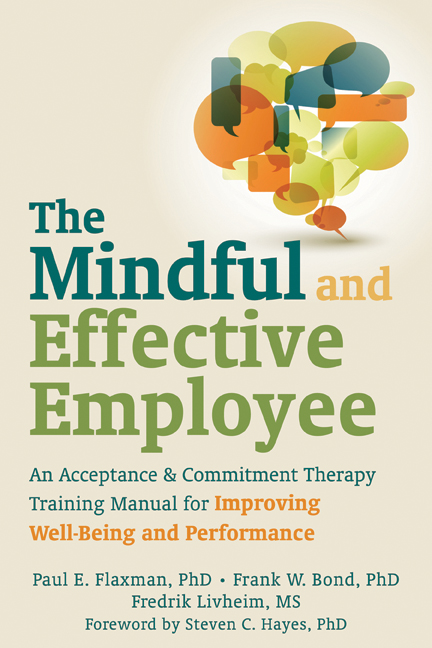A series of studies have assessed the efficacy of ACT interventions delivered to working individuals, specifically the program outlined in The Mindful and Effective Employee: An Acceptance and Commitment Therapy Training Manual for Improving Well-Being and Performance.
Bond and Bunce (2000) published the first evaluation of ACT as a worksite training program, which compared ACT (delivered in an earlier version of the “2 + 1” format featured in The Mindful and Effective Employee) with a waiting-list control group and an innovation promotion training program designed to teach workers how to reduce work-related stressors at their source. The findings, which examined change on measures of general psychological distress, depression, and propensity to be innovative at work, clearly showed the benefits of using ACT to improve mental health. ACT participants showed significantly lower levels of psychological distress than those in the innovation training and wait-list control groups. ACT also resulted in improvements in innovation potential. Consistent with ACT’s theory of change, the improvements in mental health and innovation found among the ACT participants were explained by increases in psychological flexibility, not by changes in dysfunctional cognitive content.
More recently, a group of UK public-sector employees who had attended two sessions of ACT-based training with another group of employees in the same organization who had attended training based on Donald Meichenbaum’s (1985) well-validated stress inoculation training approach (see Flaxman and Bond, 2010a), experienced significant reductions in psychological distress. The beneficial impact of ACT was significantly mediated by an increase in psychological flexibility, and not by a change in dysfunctional beliefs.
In a related study, a larger group of UK employees were examined for changes in mental health after three half-day sessions of ACT-based training, during which they were compared to a group of their coworkers who had been randomly allocated to a waiting list to receive the training six months later (Flaxman & Bond, 2010b). Three half-day sessions of ACT-based training resulted in significant improvements in general mental health across a six-month evaluation period. The largest improvements in mental health were found among a subgroup of employees who had the highest levels of psychological distress at the beginning of the study. The majority (69 percent) of these initially more distressed participants who completed Flaxman and Bond’s ACT program experienced clinically meaningful improvements to their mental health. This shows that the particular ACT-based training described in The Mindful and Effective Employee can deliver significant benefits to the high numbers of working individuals who experience a common mental health problem such as anxiety or depression.
Brinkborg et al. (2011) delivered a group-based ACT training program to improve the mental health of social workers in Sweden. The trainers in this study had been trained as part of the ACT train-the-trainer program developed by Fredrik Livheim. As a result of the intervention, a group of initially high-stress social workers experienced significant reductions in perceived stress and work-related burnout, and significant improvements in general mental health. 42 percent of the participants improved to a clinically significant degree over the course of the study. A number of other intervention studies have found similarly beneficial effects of Livheim’s train-the-trainer model for other occupational groups.
While the published research strongly indicates the efficacy of ACT interventions for increasing the well being of working populations, there are numerous unpublished studies currently under way in preparation for or pending publication. Emerging research delves further into qualitative evaluations of people’s experiences with ACT interventions, investigating the links between psychological flexibility and workers’ ability to recover during their leisure time, along with an encouraging number of new studies indicating ACT as an effective approach for preventing and reducing employee burnout. ACT researchers and practitioners continue to apply its intervention technology in new and innovative areas, including leadership development, workplace safety training, career coaching, and social-skills training.
 For more information on such innovative applications of ACT, check out the final chapter in Flaxman, Bond and Livheim’s book, The Mindful and Effective Employee.
For more information on such innovative applications of ACT, check out the final chapter in Flaxman, Bond and Livheim’s book, The Mindful and Effective Employee.
References
Bond, F. W., & Bunce, D. (2000). Mediators of change in emotion-focused and problem-focused worksite stress management interventions. Journal of Occupational Health Psychology, 5, 156–163.
Brinkborg, H., Michanek, J., Hesser, H., & Berglund, G. (2011). Acceptance and commitment therapy for the treatment of stress among social workers: A randomized controlled trial. Behaviour Research and Therapy, 49, 389–398.
Flaxman, P. E., & Bond, F. W. (2010a). A randomised worksite comparison of acceptance and commitment therapy and stress inoculation training. Behaviour Research and Therapy, 48, 816–820.
Flaxman, P. E., & Bond, F. W. (2010b). Worksite stress management training: Moderated effects and clinical significance. Journal of Occupational Health Psychology, 15, 347–358.
Meichenbaum, D. (1985). Stress inoculation training. New York: Pergamon.


 2024 Peace Playbook: 3 Tactics to Avoid Clashes with Your Partner
2024 Peace Playbook: 3 Tactics to Avoid Clashes with Your Partner